Oriel College, Oxford
| Oriel College Latin: Collegium Orielense
| |||||||||||||||||||
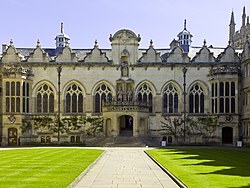
| |||||||||||||||||||
|---|---|---|---|---|---|---|---|---|---|---|---|---|---|---|---|---|---|---|---|
 | |||||||||||||||||||
| Founded: | 1326 by Adam de Brome and King Edward II | ||||||||||||||||||
| Provost: | The Lord Mendoza | ||||||||||||||||||
| Website: | www.oriel.ox.ac.uk | ||||||||||||||||||
| |||||||||||||||||||
| Location | |||||||||||||||||||
| Grid reference: | SP51610617 | ||||||||||||||||||
| Location: | 51°45’7"N, 1°15’14"W | ||||||||||||||||||
Oriel College is a constituent college of the University of Oxford in Oxford, standing in Oriel Square. The college has the distinction of being the oldest royal foundation in Oxford (a title formerly claimed by University College, whose claim of being founded by King Alfred is no longer promoted). In recognition of this royal connection, the college has also been historically known as King's College and King's Hall.[1] The reigning monarch is the official visitor of the college.[2]
The original mediæval foundation was established in 1324 by Adam de Brome, under the patronage of King Edward II, was the House of the Blessed Mary at Oxford, and the college received a royal charter in 1326.[3] In 1329, an additional royal grant of a manor house, La Oriole, eventually gave rise to its common name. The first design allowed for a provost and ten fellows, called "scholars", and the college remained a small body of graduate fellows until the 16th century, when it started to admit undergraduates.[4]
During the Civil War, Oriel played host to high-ranking members of the king's Oxford Parliament.
The main site of the college incorporates four mediæval halls: Bedel Hall, St Mary Hall, St Martin Hall, and Tackley's Inn, the last being the oldest standing mediæval hall in Oxford.
The college has nearly 40 fellows, about 300 undergraduates and some 250 graduates. Oriel was the last of Oxford's men's colleges to admit women in 1985, after more than six centuries as an all-male institution.[5] Today, however, the student body has almost equal numbers of men and women.[4] Oriel's notable alumni include two Nobel laureates; prominent fellows have included founders of the Oxford Movement. Among Oriel's more notable possessions are a painting by Bernard van Orley and three pieces of mediæval silver plate. In 2021, the college was ranked twentieth in academic performance out of thirty colleges in the Norrington Table,[6] having topped the table in 2015–16.[7]
History
Middle Ages
On 24 April 1324,[8] the Rector of the University Church, Adam de Brome, obtained a licence from King Edward II to found a "certain college of scholars studying various disciplines in honour of the Virgin" and to endow it to the value of £30 a year.[9] Brome bought two properties in 1324, Tackley's Hall, on the south side of the High Street, and Perilous Hall, on the north side of Broad Street, and as an investment, he also purchased the advowson of a church in Aberford.
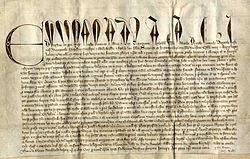
Brome's foundation was confirmed in a charter dated 21 January 1326, in which the Crown, represented by the Lord Chancellor, was to exercise the rights of Visitor; a further charter drawn up in May of that year gave the rights of Visitor to Henry Burghersh, Bishop of Lincoln, as Oxford at that time was part of the diocese of Lincoln. Under Edward's patronage, Brome diverted the revenues of the University Church to his college, which thereafter was responsible for appointing the Vicar and providing four chaplains to celebrate the daily services in the church.[3] The college lost no time in seeking royal favour again after Edward II was deposed, and Edward III confirmed his father's favour in February 1327, but the amended statutes with the Bishop of Lincoln as Visitor remained in force. In 1329, the college received by royal grant a large house belonging to the Crown, known as La Oriole,[10] on the site of what is now First Quad.
It is from this property that the college acquired its common name, "Oriel"; the name was in use from about 1349. The word referred to an oratoriolum, or oriel window, forming a feature of the earlier property.[9]
In the early 1410s several fellows of Oriel took part in the disturbances accompanying Archbishop Arundel's attempt to stamp out Lollardy in the university; the Lollard belief that religious power and authority came through piety and not through the hierarchy of the Church particularly inflamed passions in Oxford, where its proponent, John Wycliffe, had been head of Balliol. Disregarding the provost's authority, Oriel's fellows fought bloody battles with other scholars, killed one of the Chancellor's servants when they attacked his house, and were prominent among the group that obstructed the Archbishop and ridiculed his censures.[1]
In 1442, Henry VI sanctioned an arrangement whereby the town was to pay the college £25 a year from the fee farm (a type of feudal tax) in exchange for decayed property, allegedly worth £30 a year, which the college could not afford to keep in repair. The arrangement was cancelled in 1450.[11]
Early Modern
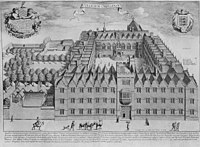
In 1643, a general obligation was imposed on Oxford colleges to support the Royalist cause in the Civil War. The King called for Oriel's plate, and almost all of it was given, the total weighing 29 lb. 0 oz. 5 dwt. of gilt, and 52 lb. 7 oz. 14 dwt}}. of "white" plate. In the same year the college was assessed at £1 of the weekly sum of £40 charged on the colleges and halls for the fortification of the city.[3] When the Oxford Parliament was assembled during the Civil War in 1644, Oriel housed the executive committee of the Privy Council, Parliament being held at neighbouring Christ Church. Following the defeat of the Royalist cause, the university was scrutinised by the Parliamentarians, and five of the eighteen Oriel fellows were removed. The Visitors, on their own authority, elected fellows between 1648 and October 1652, when without reference to the Commissioners, John Washbourne was chosen; the autonomy of the college in this respect seems to have been restored.[3]
In 1673 James Davenant, a fellow since 1661, complained to William Fuller, then Bishop of Lincoln, about Provost Say's conduct in the election of Thomas Twitty to a fellowship. Bishop Fuller appointed a commission that included the Vice-Chancellor, Peter Mews; the Dean of Christ Church, John Fell; and the Principal of Brasenose, Thomas Yates. On 1 August Fell reported to the Bishop that:[3]
When this Devil of buying and selling is once cast out, your Lordship will, I hope, take care that he return not again, lest he bring seven worse than himself into the house after 'tis swept and garnisht.
On 24 January 1674, Bishop Fuller issued a decree dealing with the recommendations of the commissioners—a majority of all the fellows should always be present at an election, so the provost could not push an election in a thin meeting, and fellows should be admitted immediately after their election. On 28 January Provost Say obtained from the King a recommendation for Twitty's election, but it was withdrawn on 13 February, following the Vice-Chancellor's refusal to swear Twitty into the university and the Bishop's protests at Court.[3]

During the early 1720s, a constitutional struggle began between the provost and the fellows, culminating in a lawsuit. In 1721, Henry Edmunds was elected as a fellow by 9 votes to 3; his election was rejected by Provost George Carter, and on appeal, by the Visitor, Edmund Gibson, then Bishop of Lincoln. The provost continued to reject candidates, fuelling discontent among the fellows, until a writ of attachment against the Bishop of Lincoln was heard between 1724 and 1726. The opposing fellows, led by Edmunds, appealed to the original statutes, claiming the Crown as Visitor, making Gibson's decisions invalid; Provost Carter, supported by Bishop Gibson, appealed to the second version, claiming the Bishop of Lincoln as Visitor. The jury decided for the fellows, supporting the original charter of Edward II.
In a private printing of 1899, Provost Shadwell lists thirteen Gaudies observed by the college during the 18th century; by the end of the 19th century all but two, the Feast of the Immaculate Conception and the Purification of the Virgin, had ceased to be celebrated.[3]
Modern
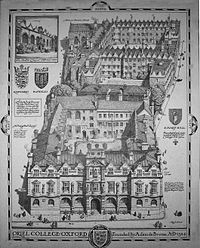
In the early 19th century, the reforming zeal of Provosts John Eveleigh and Edward Copleston gained Oriel a reputation as the most brilliant college of the day. It was the centre of the "Oriel Noetics" — clerical liberals such as Richard Whately and Thomas Arnold were fellows,[12] and during the 1830s, two intellectually eminent fellows of Oriel, John Keble and John Henry Newman, supported by Canon Pusey (also an Oriel fellow initially, later at Christ Church) and others, formed a group known as the Oxford Movement, alternatively as the Tractarians, or familiarly as the Puseyites. Tension arose in college since Provost Edward Hawkins was a determined opponent of the Movement.
During the First World War, a wall was built dividing Third Quad from Second Quad to accommodate members of Somerville College in St Mary's Hall while their college buildings were being used as a military hospital. At that time Oxford separated male and female students as far as possible; Vera Brittain, one of the Somerville students, recalled an amusing occurrence during her time there in her autobiography, Testament of Youth:
[...] the few remaining undergraduates in the still masculine section of Oriel not unnaturally concluded that it would be a first-rate "rag" to break down the wall which divided them from the carefully guarded young females in St. Mary Hall. Great perturbation filled the souls of the Somerville dons when they came down to breakfast one morning to find that a large gap had suddenly appeared in the protecting masonry, through which had been thrust a hilarious placard:
'OO MADE THIS 'ERE 'OLE?
MICE!!!Throughout that day and the following night the Senior Common Room, from the Principal downwards, took it in turns to sit on guard beside the hole, for fear any unruly spirit should escape through it to the forbidden adventurous males on the other side.[13]
In 1985, the college became the last all-male college in Oxford to start to admit women for matriculation as undergraduates. In 1984, the Senior Common Room voted 23–4 to admit women undergraduates from 1986. The Junior Common Room president believed that "the distinctive character of the college will be undermined".[14]
Buildings and environs
First Quad (Front Quad)

The Oriel Street site was acquired between 1329 and 1392.[11] Nothing survives of the original buildings, La Oriole and the smaller St Martin's Hall in the south-east; both were demolished before the quadrangle was built in the artisan mannerist style during the 17th century. The south and west ranges and the gate tower were built around 1620 to 1622; the north and east ranges and the chapel buildings date from 1637 to 1642. The façade of the east range forms a classical E shape comprising the college chapel, hall and undercroft. The exterior and interior of the ranges are topped by an alternating pattern of decorative gables. The gate house has a Perpendicular portal and canted Gothic oriel windows, with fan vaulting in the entrance. The room above has a particularly fine plaster ceiling and chimney piece of stucco caryatids and panelling interlaced with studded bands sprouting into large flowers.[10]
Hall
In the centre of the east range, the portico of the hall entrance commemorates its construction during the reign of I with the legend Regnante Carolo, 'Charles, being king', in capital letters in pierced stonework. The portico was completely rebuilt in 1897, and above it are statues of two kings: Edward II, the college's founder, on the left, and probably either Charles I or James I, although this is disputed; above those is a statue of Mary, after whom the college is officially named. The top breaks the Jacobean tradition and has classical pilasters, a shield with garlands, and a segmental pediment.[10]
The hall has a hammerbeam roof and a louvre in the centre, which was originally the means of escape for smoke rising from a fireplace in the centre of the floor. The wooden panelling was designed by Ninian Comper and was erected in 1911 in place of some previous 19th-century Gothic type, though even earlier panelling, dating from 1710, is evident in the buttery.[15]
Behind the high table is a portrait of Edward II; underneath is a longsword brought to the college in 1902 after being preserved for many years on one of the college's estates at Swainswick, near Bath. On either side are portraits of Sir Walter Raleigh and Joseph Butler. The other portraits around the hall include other prominent members of Oriel such as Matthew Arnold, Thomas Arnold, James Anthony Froude, John Keble, John Henry Newman, Richard Whately and John Robinson. In 2002, the college commissioned one of the largest portraits of Queen Elizabeth II, measuring 92 inches by 58 inches, from Jeff Stultiens to hang in the hall; the painting was unveiled the following year.[16][17] The stained glass in the windows display the coats of arms of benefactors and distinguished members of the college; three of the windows were designed by Ninian Comper. The window next to the entrance on the east side contains the arms of Regius Professors of Modern History who have been ex officio fellows of the college.[1]
Chapel
The current chapel is Oriel's third, the first being built around 1373 on the north side of First Quadrangle. By 1566, the chapel was located on the south side of the quadrangle, as shown in a drawing made for Elizabeth I's visit to Oxford in that year. The present building was consecrated in 1642 and despite subsequent restorations it largely retains its original appearance.[18]
The bronze lectern was given to the college in 1654. The black and white marble paving dates from 1677 to 1678. Except for the pews on the west, dating from 1884, the panelling, stalls and screens are all 17th-century, as are the altar and carved communion rails. Behind the altar is the oil-on-panel painting The Carrying of the Cross, also titled Christ Falls, with the Cross, before a City Gate, by the Flemish Renaissance painter Bernard van Orley.[19] A companion piece to the painting is in the National Gallery of Scotland. The organ case dates from 1716; originally designed by Christopher Schreider for St Mary Abbots Church, Kensington, it was acquired by Oriel in 1884.[20]
Above the entrance to the chapel is an oriel that, until the 1880s, was a room on the first floor that formed part of a set of rooms that were occupied by Richard Whately, and later by John Henry Newman. Whately is said to have used the space as a larder and Newman is said to have used it for his private prayers – when the organ was installed in 1884, the space was used for the blower. The wall that once separated the room from the ante-chapel was removed, making it accessible from the chapel. The organ was built by J. W. Walker & Sons in 1988;[20] in 1991 the space behind the organ was rebuilt as an oratory and memorial to Newman and the Oxford Movement. A new stained-glass window designed by Vivienne Haig and realised by Douglas Hogg was completed and installed in 2001.[18]
During the late 1980s, the chapel was extensively restored with the assistance of donations from Lady Norma Dalrymple-Champneys. During this work, the chandelier, given in 1885 by Provost Shadwell while still a fellow, was put back in place, the organ was restored, the painting mounted behind the altar, and the chapel repainted. A list of former chaplains and organ scholars was erected in the ante-chapel.[21]
Second Quad (Back Quad)
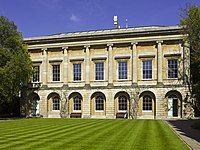
Originally a garden, the demand for more accommodation for undergraduates in the early 18th century resulted in two free-standing blocks being built. The first block erected was the Robinson Building on the east side, built in 1720 by Bishop Robinson at the suggestion of his wife, as the inscription over the door records. Its twin block, the Carter Building, was erected on the west side in 1729, as a result of a benefaction by Provost Carter. The two buildings stood for nearly a hundred years as detached blocks in the garden, and the architectural elements of First Quad are repeated on them — only here the seven gables are all alike. Between 1817 and 1819,[10] they were joined up to First Quad with their present, rather incongruous connecting links. In the link to the Robinson Building, two purpose-built rooms have been incorporated – the Champneys Room, designed by Weldon Champneys, the nephew of Basil Champneys, and the Benefactors Room, a panelled room honouring benefactors of the college. A Gothic oriel window, belonging to the provost's lodgings, was added to the Carter Building in 1826.[10]

The north range houses the library and senior common rooms; designed in the Neoclassical style by James Wyatt, it was built between 1788 and 1796 to accommodate the books requested by Edward, Baron Leigh, formerly High Steward of the university and an Orielensis, whose gift had doubled the size of the library.[22] The two-storey building has rusticated arches on the ground floor and a row of Ionic columns above, dividing the façade into seven bays — the ground floor contains the first purpose-built senior common rooms in Oxford, above is the library.[1]
On 7 March 1949, a fire spread from the library roof; over 300 printed books and the manuscripts on exhibition were completely destroyed, and over 3,000 books needed repair,[22] though the main structure suffered little damage and restoration took less than a year.[1]
Third Quad (St Mary's Quad)
The south, east and west ranges of Third Quadrangle contain elements of St Mary Hall, which was incorporated into Oriel in 1902; less than a decade later, the Hall's buildings on the northern side were demolished for the construction of the Rhodes Building. Bedel Hall in the south was formally amalgamated with St Mary Hall in 1505.
In the south range, parts of the mediæval buildings survive and are incorporated into staircase ten — the straight, steep flight of stairs and timber-framed partitions date from a mid-15th century rebuilding of St Mary Hall. The former Chapel, Hall and Buttery of St Mary Hall, built in 1640, form part of the Junior Library and Junior Common Room. Viewed from Third Quad, the chapel, with its Gothic windows, can be seen to have been built neatly on top of the Hall, a unique example in Oxford of such a plan.
On the east side of the quad is a simple rustic style timber-frame building; known as "the Dolls' House", it was erected by Principal King in 1743.
In 1826 an ornate range was erected by St Mary Hall in the Gothic Revival style, incorporating the old gate of St Mary Hall, on the west side of the quad. Designed by Daniel Robertson, it contains two quite ornate oriels placed asymmetrically, one is of six lights, the other four. They are the best example of the pre-archaeological Gothic in Oxford.[10] The large oriel on the first floor at the north end was once the drawing room window of the Principal of the Hall. Parts of the street wall incorporated into this range show traces of blocked windows dating from the same period of rebuilding in the 15th century as the present-day staircase ten.[1]

The Rhodes Building, pictured, was built in 1911 using £100,000 left to the college for that purpose by former student Cecil Rhodes.[10] It was designed by Basil Champneys and stands on the site of the house of the St Mary Hall Principal, on the High Street. Champneys's first proposal for the building included an open arcade to the High Street, a domed central feature and balustraded parapet. The left hand block and much of the centre was to be given up to a new provost's lodging, and the five windows on the first floor above the arcade were to light a gallery belonging to the lodging. The college eventually decided to retain the existing provost's lodging and demanded detailing "more in accordance with the style which has become traditional in Oxford". It became the last building of the 'Jacobean revival' style in Oxford.
The staircases of the interior façade are decorated with cartouches similar to those found in First Quad, and likewise bear the arms of important figures in the college's history; (13) Sir Walter Raleigh who was an undergraduate from 1572 to 1574, (14) John Keble who was a fellow between 1811 and 1835, (archway) Edward Hawkins who was provost from 1828 until 1882 and (15) Gilbert White who was an undergraduate from 1739 until 1743 and a fellow from 1744 until 1793.[citation needed]
The building was not entirely well received; William Sherwood, Mayor of Oxford and Master of Magdalen College School, wrote: "Oriel [has] broken out into the High, ... destroying a most picturesque group of old houses in so doing, and, to put it gently, hardly compensating us for their removal."[23]
Bartlemas
Bartlemas is a conservation area that incorporates the remaining buildings of a leper hospital founded by Henry I;[24] it includes the sports grounds for Oriel, Jesus and Lincoln Colleges, along with landscaping for wildlife and small scale urban development.

In 1326 Provost Adam de Brome was appointed warden of St Bartholomew's;[24] a leper hospital in Cowley Marsh, the hospital was later granted to the college by Edward III, along with the payments it had been receiving from the fee farm. It was increasingly used as a rest house for sick members of the college needing a change of air.
In 1649 the college rebuilt the main hospital range north of the chapel, destroyed in the Civil War, as a row of four almshouses, called Bartlemas House.[25] Bartlemas Chapel and two farm cottages are the other extant buildings.[26]
Outside links
| ("Wikimedia Commons" has material about Oriel College, Oxford) |
- Oriel College
- Oriel JCR — the undergraduate body of the college
- Oriel MCR — the graduate body of the college
- Virtual Tour
- Oriel College Boat Club
- The Poor Print – Student-run publication of Oriel College
References
- ↑ 1.0 1.1 1.2 1.3 1.4 1.5 Watt, D. E. (editor), Oriel College, Oxford (Trinity term, 1953) — Oxford University Archaeological Society, uses material collected by C. R. Jones, R. J. Brenato, D. K. Garnier, W. J. Frampton and N. Covington, under advice from W. A. Pantin, particularly in respect of the architecture and treasures (manuscripts, printed books and silver plate) sections. 16 page publication, produced in association with the Ashmolean Museum as part of a college guide series.
- ↑ Fantato, Damian (29 March 2013). "Queen's visit: Special lunch fit for a Queen". Oxford Mail. https://www.oxfordmail.co.uk/news/10322505.queens-visit-special-lunch-fit-queen/.
- ↑ 3.0 3.1 3.2 3.3 3.4 3.5 3.6 Rannie, David (1900). Oriel College. University of Oxford College Histories. London: F. E. Robinson & Co.. https://archive.org/details/orielcollege00rannrich.
- ↑ 4.0 4.1 Oriel College Oxford, A short guide. Oriel College Development Trust on behalf of Oriel College, Oxford.
- ↑ "College History". https://www.oriel.ox.ac.uk/about-college/college-history.
- ↑ "Undergraduate Degree Classifications". https://www.ox.ac.uk/about/facts-and-figures/undergraduate-degree-classifications.
- ↑ Sutton, Daniel (22 August 2016). "Breaking: Oriel tops 2015/16 Norrington Table". Cherwell. https://cherwell.org/2016/08/22/breaking-oriel-tops-201516-norrington-table/.
- ↑ Christopher and Edward Hibbert's The Encyclopedia of Oxford at p. 291 gives the date as 24 April, with the wording "Adam de Brome, obtained from King Edward II, licence". Jeremy Catto's article about Brome in the Dictionary of National Biography|Oxford Dictionary of National Biography gives the date as 20 April, with a similar wording. Rannie's Oriel College at p. 4 has "On April 28, 1324, Letters Patent issued by the King giving licence"
- ↑ 9.0 9.1 Hibbert, Christopher, The Encyclopedia of Oxford London: Macmillan (1988) pp. 291–295.
- ↑ 10.0 10.1 10.2 10.3 10.4 10.5 10.6 Nikolaus Pevsner: Pevsner Architectural Guides
- ↑ 11.0 11.1 A History of the County of - Volume 4 pp 3-73: The City of Oxford (Victoria County History)
- ↑ Newman's Oxford – A Guide for Pilgrims, Ecumenical undertaking between the Vicar of Littlemore and the Fathers of the Oratory at Birmingham — (Oxonian Rewley Press, c. 1978), p. 10
- ↑ Brittain, Vera (1933). Testament of Youth: An Autobiographical Study of the Years 1900–1925. Penguin Books. p. 136. ISBN 9780140188448.
- ↑ Cherwell Retropsective (1984 section) The Cherwell 24 November 1989 edition.
- ↑ A History of the County of - Volume 3 pp 119-131: Oriel College and St Mary Hall (Victoria County History)
- ↑ "Oriel College, University of Oxford". https://artuk.org/visit/venues/oriel-college-university-of-oxford-7528.
- ↑ "Giant Queen portrait unveiled". BBC News. 26 September 2003. http://news.bbc.co.uk/1/hi/entertainment/3141696.stm.
- ↑ 18.0 18.1 "History of the Chapel". 29 April 2016. https://www.oriel.ox.ac.uk/life-oriel/chapel/history-chapel.
- ↑ "Christ Falls, with the Cross, before a City Gate". https://artuk.org/discover/artworks/christ-falls-with-the-cross-before-a-city-gate-222950.
- ↑ 20.0 20.1 Pacey, Robert; Popkin, Michael (1980). The Organs of Oxford (2nd ed.). Oxford: Positif Press. p. 73. ISBN 9780906894255.
- ↑ "Oriel College Chapel Guide & History". (reference for the section). http://www.oriel.ox.ac.uk/content/history.
- ↑ 22.0 22.1 "Oriel College History of the Library". http://www.oriel.ox.ac.uk/content/history-library.
- ↑ "95–101 High Street, Oxford". oxfordhistory.org.uk. http://www.oxfordhistory.org.uk/high/tour/south/095_101.html.
- ↑ 24.0 24.1 A History of the County of - Volume 2 pp 157-158: Hospitals: St Bartholomew, Oxford (Victoria County History).
- ↑ Sherwood, Jennifer, A guide to the Churches of Oxfordshire (1989) p. 143 has grant date as 1327 — published by Robert Dugdale in association with Oxfordshire Historic Churches Trust ISBN 0-946976-03-1.
- ↑ "Conservation Area Appraisal: Bartlemas". https://www.oxford.gov.uk/download/downloads/id/6936/psd23_-_bartlemas_conservation_area_appraisal.pdf.
| Colleges of the University of Oxford | |
|---|---|
| Colleges:
All Souls • Balliol • Brasenose • Christ Church • Corpus Christi • Exeter • Green Templeton • Harris Manchester • Hertford • Jesus • Keble • Kellogg • Lady Margaret Hall • Linacre • Lincoln • Magdalen • Mansfield • Merton • New College • Nuffield • Oriel • Pembroke • The Queen's • Reuben • St Anne's • St Antony's • St Catherine's • St Cross • St Edmund Hall • St Hilda's • St Hugh's • St John's • St Peter's • Somerville • Trinity • University • Wadham • Wolfson • Worcester |
 |
| Permanent private halls:
Blackfriars • Campion Hall • Regent's Park College • St Benet's Hall • St Stephen's House • Wycliffe Hall | |
